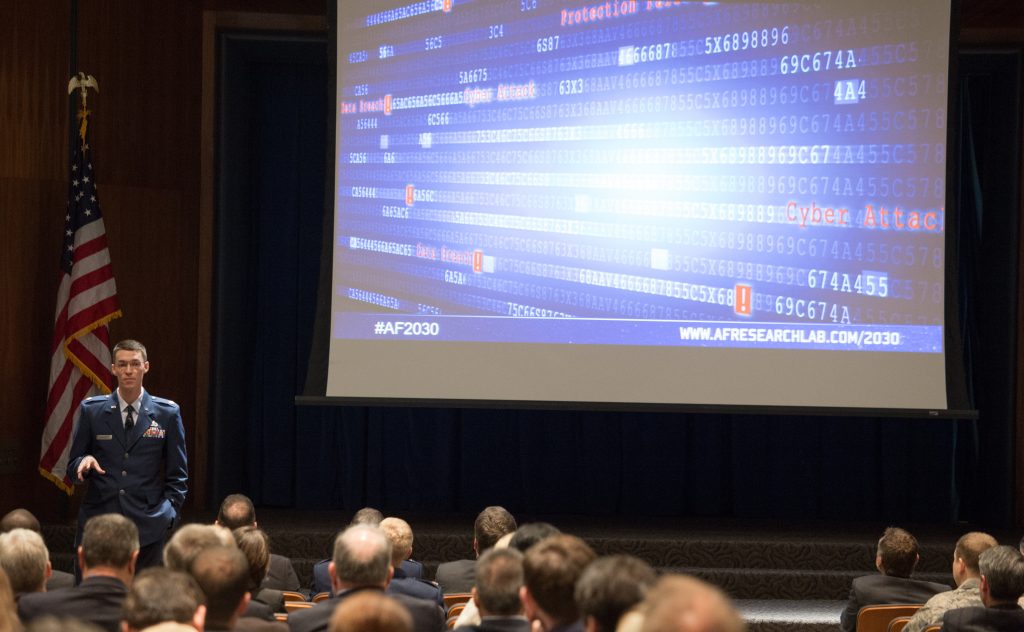IU Bloomington campus hosted the Air Force Science and Technology 2030 Initiative

More than 300 professionals in higher education, government and industry convened at the Indiana University Bloomington campus May 10 and 11 to conceive products and methods to maintain the U.S. Air Force’s air superiority through 2030 and beyond.
The Air Force Science and Technology 2030 Initiative includes six conferences held at universities across the United States. The events are independent of one another, with leaders from the Air Force, including the Air Force Research Laboratory, attending each. The IU event included speeches from IU President Michael A. McRobbie, Air Force Research Laboratory Commander Maj. Gen. William Cooley, Air Force Maj. Brook Bentley, IU Vice President for Research Fred H. Cate and IU Bloomington Associate Vice President for Research Rick Van Kooten.

Participants at the IU event were invited to contribute to one of six content tracks: artificial intelligence for mission planning and execution, cyber assurance and trusted microelectronics, human performance and human-computer interface, next generation propulsion and advanced manufacturing, novel sensing and data fusion, or an ad hoc track.
Researchers from the Midwest and adjacent states began the tracks with brief presentations about their innovative research. Participants then engaged in ideation sessions to elaborate upon the technologies, which led to a new set of ideas recorded by facilitators and submitted to Air Force Research Laboratory officials.

During his speech, McRobbie noted that IU appreciates grants from the U.S. Air Force that have supported faculty research into artificial intelligence, atomic physics, quantum information and other disciplines.

“IU is committed to continuing and strengthening its partnership with the Air Force, and with the Department of Defense more broadly, to bring the university’s resources and research expertise to bear to help strengthen our national security,” McRobbie said.
McRobbie’s speech is available online.
Cooley said discussions about national security have been reframed because of worldwide competition.

“In my entire career, the United States has been the dominant military force on the planet, and that is being challenged,” Cooley said. “This matters to the economy and to our influence across the globe on all fronts. We are asking for assistance from the smart folks around the country to help us in our efforts to maintain national security and military dominance. We have resources to bring to bear, but we don’t have enough to tackle this alone. We are looking for the best and brightest to help us.”

Brian McJilton, program management lead of the Science and Technology 2030 Initiative, said Secretary of the Air Force Heather Wilson tasked the Air Force Research Laboratory to address several questions.
“We are asking, ‘What are those technology areas of the future that we need to invest in to ensure we have the leading edge over our adversaries?” McJilton said.
“We also are looking at how industry, higher education and other government organizations rapidly produce ideas and concepts from the benchtop into the field. We want to learn the lessons they have learned, because the importance of staying at the cutting edge is ever present with our adversaries.”

Kirk White, IU assistant vice president for strategic partnerships, said the most important part of the event was highlighting lesser-known developments in technology for the Air Force and other attendees.

“These technologies that are just starting to develop will help set the agenda for technology development for our nation’s defense,” White said. “This could lead to new partnerships with the Air Force Research Laboratory, but also collaborations between universities that didn’t know that faculty and postdoctoral students are working on the same research or complementary research.”
Cooley spoke about the importance of developing relationships through the Science and Technology 2030 Initiative.
“As enticing as websites and other online communications might be, they still don’t replace human interactions: meeting with folks, sitting down and breaking bread, understanding shared interests, and having conversations about where we can partner,” he said. “My hope is that these events aren’t just a one-time engagement, but rather the initiation of a more enduring relationship that we can leverage to tap into the innovations being developed.”

Leave a Reply